I'm cross-posting this here in case folks might be interested but haven't seen it over at Rocketry Planet.
Last weekend at Mile High Mayhem I flew my 38mm carbon fiber rocket on an I600, trying to see how high I could get an I-powered rocket. Due to a premature main deployment, the rocket landed almost 5 miles from the pad, and I finally recovered it yesterday after a lot of help from several other NCR club members.
The build thread for the rocket is here. I started on it late last year, and I've done everything I can do optimize it for maximum altitude, while keeping a dual deployment design.
Last Sunday I launched it from my tower with a nice clean boost, and the rocket went right out of sight. The altimeter turned on the transmitter at the main deployment altitude, but that was about 14 minutes after liftoff, and I only got a minute or so of tracking direction before it went over the horizon.
Here's data from the new Featherweight Interface program:
Altitude and temperature, for the whole flight:
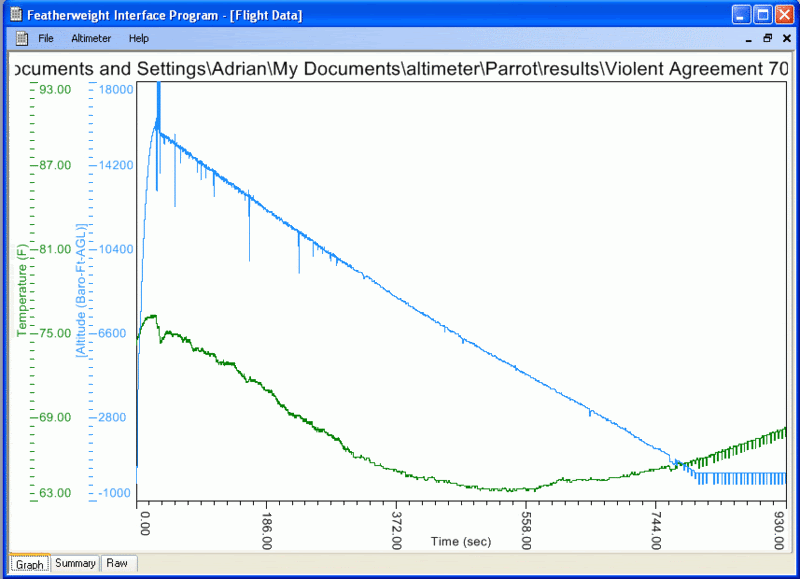
Velocity, accel, and altitude up through apogee deployment and the premature main deployment
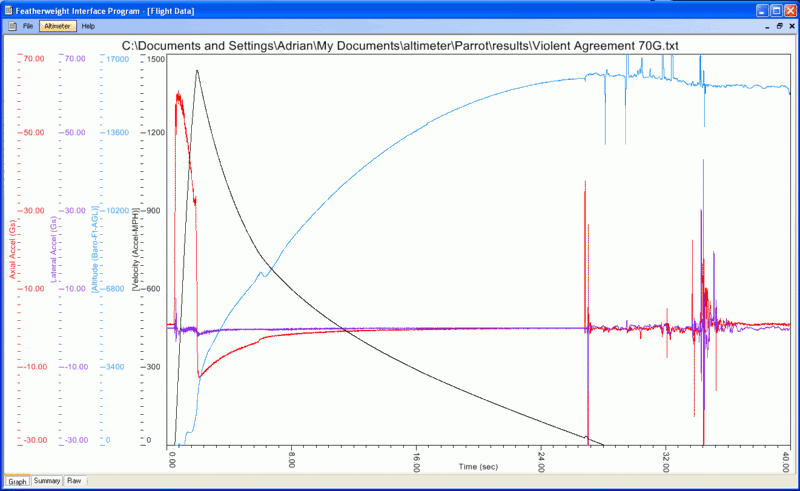
Zoomed into the the motor burn:
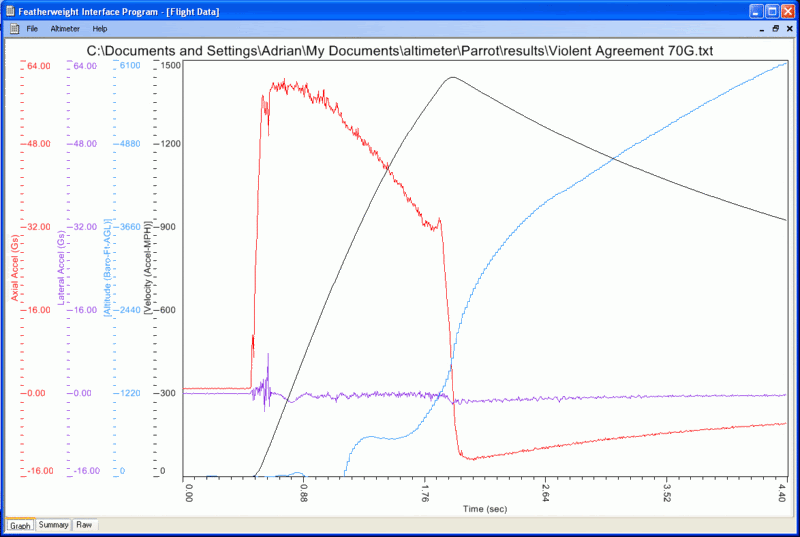
One altimeter reported 15960 feet right as the last data point before the apogee charge fired, and the other one reported 15969 feet.
Then I did some more detailed post-processing of the data using the Excel template on the Featherweight Altimeters site:
First, I adjust the accel offset, scale factor, and time factor so that the integrated accel calculated altitude matches the baro-based altitude:
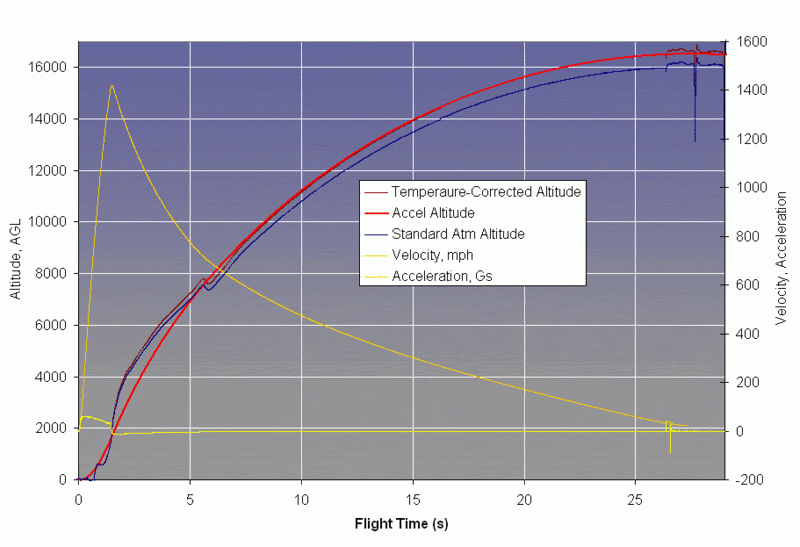
This gives me a set of accelerometer data that is consistent with the baro data. Here's the residual error between the two. Note how there is a little step change near 16 seconds. I believe that is when the delay burned through, equalizing the pressure between the motor and the rest of the rocket. Good thing I was using electronic ejection! It was still going up at 250 mph when the charge burned through.
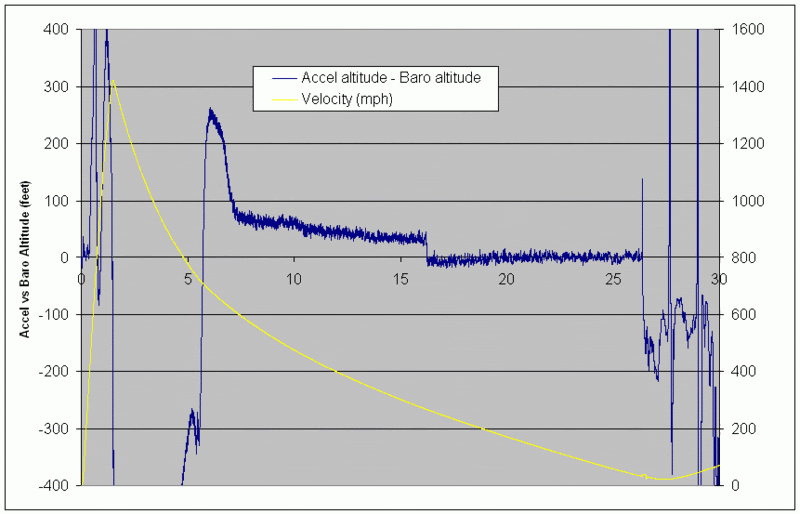
Now with good accel data, there's all kinds of things you can calculate. In particular, I'm happy with how the Cd vs. velocity came out:
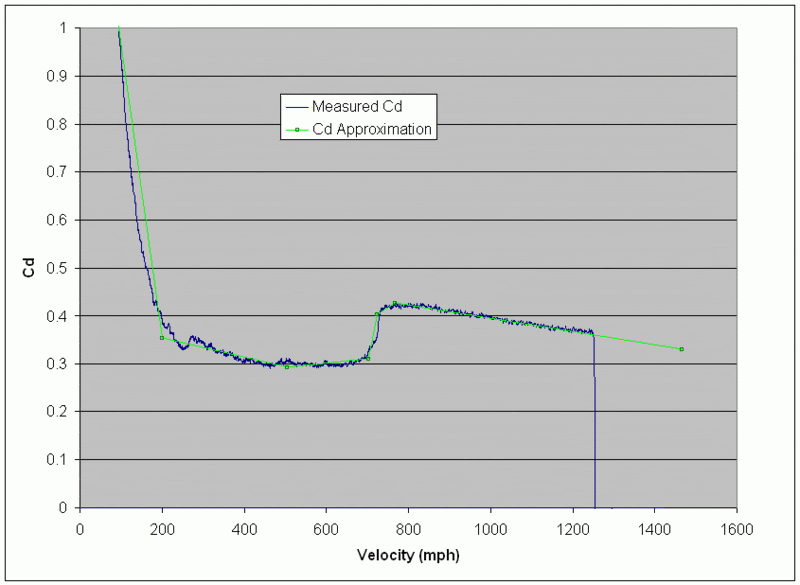
Compare that to the Cd vs. velocity data I got for conical and ogive-ish rockets last summer:
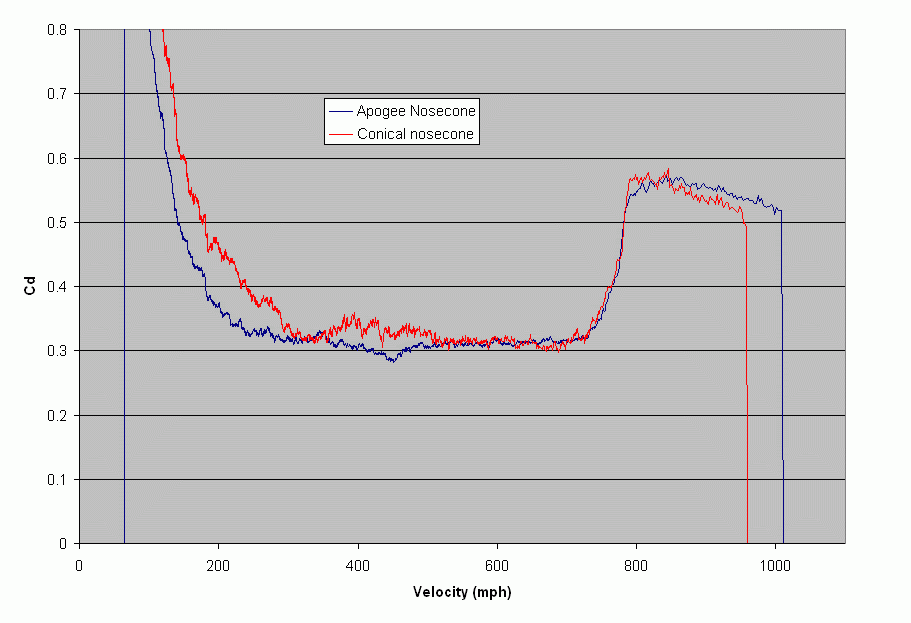
The supersonic penalty is only half what it was for either the conical or Apogee nosecones. Sweet.
Then I can take the Cd vs. velocity data that I measured after burnout, and use that to see what the aero drag was during the burn, and subtract that off from the measured force to get a nice thrust vs. time curve for this flight:
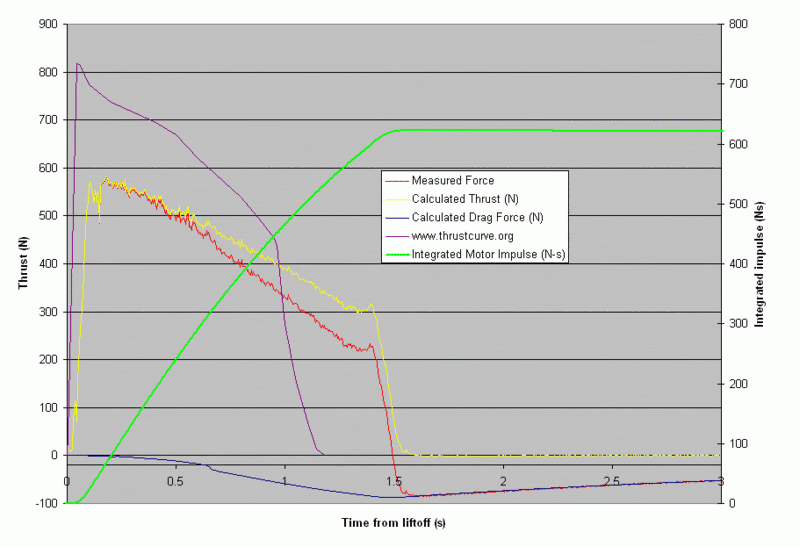
For reference, I also plotted the I600 thrust curve from thrustcurve.org. I think AT made a propellant adjustment or something, because this motor was significantly slower than spec. It's really more like an I400, which was great for this altitude shot. Two summers ago, Chris LaPanse flew a prototype Parrot in his I600 Cirrus Dart shot, and measured the same thing. This thrust curve is built on top of a lot of derived data, but the burn time is straight from the altimeter, and there's a big difference between a 1.2 second burn and a 1.6 second burn. I calculated the integrated impulse to be about 620 Nsec.
Also note that I lost a noticeable amount of impulse bouncing through the launch rails. You can see it in the lateral accel near the top of the page. It makes me wonder whether I should reduce or increase the spacing between the rails and the rocket, and if I'm at the point where additional launch tower length hurts rather than helps. The exit velocity from the tower was 117 mph.
Last weekend at Mile High Mayhem I flew my 38mm carbon fiber rocket on an I600, trying to see how high I could get an I-powered rocket. Due to a premature main deployment, the rocket landed almost 5 miles from the pad, and I finally recovered it yesterday after a lot of help from several other NCR club members.
The build thread for the rocket is here. I started on it late last year, and I've done everything I can do optimize it for maximum altitude, while keeping a dual deployment design.
Last Sunday I launched it from my tower with a nice clean boost, and the rocket went right out of sight. The altimeter turned on the transmitter at the main deployment altitude, but that was about 14 minutes after liftoff, and I only got a minute or so of tracking direction before it went over the horizon.
Here's data from the new Featherweight Interface program:
Altitude and temperature, for the whole flight:

Velocity, accel, and altitude up through apogee deployment and the premature main deployment

Zoomed into the the motor burn:

One altimeter reported 15960 feet right as the last data point before the apogee charge fired, and the other one reported 15969 feet.
Then I did some more detailed post-processing of the data using the Excel template on the Featherweight Altimeters site:
First, I adjust the accel offset, scale factor, and time factor so that the integrated accel calculated altitude matches the baro-based altitude:

This gives me a set of accelerometer data that is consistent with the baro data. Here's the residual error between the two. Note how there is a little step change near 16 seconds. I believe that is when the delay burned through, equalizing the pressure between the motor and the rest of the rocket. Good thing I was using electronic ejection! It was still going up at 250 mph when the charge burned through.

Now with good accel data, there's all kinds of things you can calculate. In particular, I'm happy with how the Cd vs. velocity came out:

Compare that to the Cd vs. velocity data I got for conical and ogive-ish rockets last summer:

The supersonic penalty is only half what it was for either the conical or Apogee nosecones. Sweet.
Then I can take the Cd vs. velocity data that I measured after burnout, and use that to see what the aero drag was during the burn, and subtract that off from the measured force to get a nice thrust vs. time curve for this flight:

For reference, I also plotted the I600 thrust curve from thrustcurve.org. I think AT made a propellant adjustment or something, because this motor was significantly slower than spec. It's really more like an I400, which was great for this altitude shot. Two summers ago, Chris LaPanse flew a prototype Parrot in his I600 Cirrus Dart shot, and measured the same thing. This thrust curve is built on top of a lot of derived data, but the burn time is straight from the altimeter, and there's a big difference between a 1.2 second burn and a 1.6 second burn. I calculated the integrated impulse to be about 620 Nsec.
Also note that I lost a noticeable amount of impulse bouncing through the launch rails. You can see it in the lateral accel near the top of the page. It makes me wonder whether I should reduce or increase the spacing between the rails and the rocket, and if I'm at the point where additional launch tower length hurts rather than helps. The exit velocity from the tower was 117 mph.



